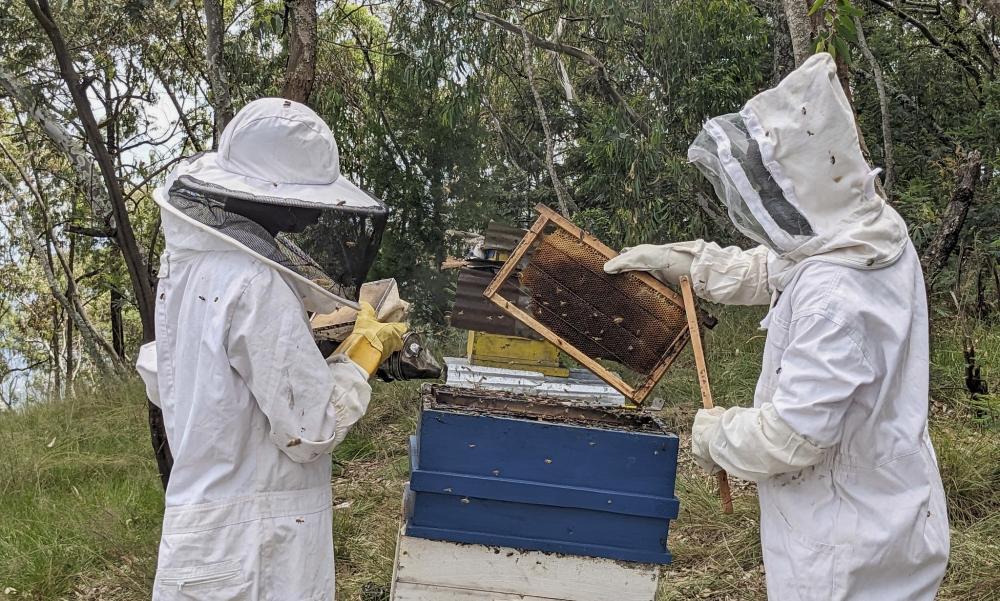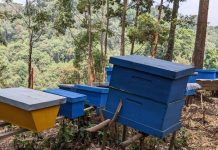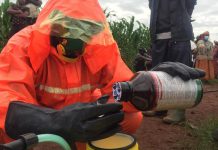Africa-Press – Rwanda. Grace Mbabazi, the Managing Director of M&M Sozo Ltd, a local honey export company, has her sights set on tapping global markets. Her focus is now on increasing domestic honey production to be able to meet demand from buyers in China, Dubai, and Europe, among others.
For her – and exporters in general – the issue at hand is that Rwanda’s honey production has not kept up with the export market demand.
Her company currently exports between 90 and 120 tonnes of honey per year, with prices, overall, ranging from $10 to $12 per kilogramme, she said.
However, due to limited domestic production, that output barely scratches the surface of what international markets are requesting.
“China alone needs a container – between 28 and 30 tonnes of honey – every month. That’s a demand I can’t meet right now,” Mbabazi told The New Times of her company’s honey export demand, stressing the need to scale up production.
Inside Rutsiro Honey Ltd store.
Mbabazi plans to expand her honey business by investing in modern beekeeping and advanced honey processing equipment. She is targeting outlays of around Rwf5 billion as a loan to accelerate growth.
“We see the potential, but we need investment to meet it,” she said, stating that expanding production and investments will benefit communities such as through income generation.
A market potential underutilised, need for action
During an August 14 meeting in Kigali on agricultural export development, Solange Murekezi, Chairperson of beekeeping value chain – a private sector network in Rwanda – said that while the government has been helping exporters with quality control and access to markets, the real potential of this sector is yet to be tapped due to inadequate supply.
Murekezi attributes much of this supply challenge to current land use policy that does not sufficiently consider the unique needs of the beekeeping sector.
She said that most mature forests are given to the private sector for other purposes.
“We don’t have any designated area that we can use to produce at least 500 tonnes of monofloral honey,” she said.
Monofloral honey is honey that comes primarily from the nectar of a single type of flower or tree, resulting in a distinctive and consistent taste, color, and aroma.
Murekezi acknowledged that the Rwanda Agriculture and Animal Resources Board (RAB) has supported efforts to identify land for beekeeping, but the spaces found so far are insufficient to produce the quantity needed for consistent exports.
While Rwanda has secured markets to export honey to different countries, she said that it has not yet met the production volumes required to supply them.
She expressed the need to access mature forest areas that can support sustainable honey production.
A ministerial response
Addressing the concerns, the Minister of Agriculture and Animal Resources, Mark Cyubahiro Bagabe, recognised the challenges – including a lack of designated, protected areas where beekeeping can be practiced sustainably – and promised to work towards a response.
“I do believe that beekeeping is very, very much compatible with our forests in the country. The beauty with forests is that there’s no spraying, so there’s no issue of contamination [with pesticides]. So I think that the proposition from the beekeepers is worth listening to and worth investigating,” he said.
Bagabe committed to engaging the Rwanda Forestry Authority and other government entities to “see if we can come up with more of a policy intention to create that kind of space” for beekeepers.
“As we say, for example, we are growing horticulture here, in the same spirit, we can be able to demarcate particular areas for beekeeping. And I think that’s the homework that we have been given, which we are going to work on,” he said.
Honey outlook under agriculture strategic plan
According to the Ministry’s 2023/24 annual report, Rwanda’s honey production reached 7,621 tonnes in 2024—up from 7,240 tonnes in 2023 and 6,135 tonnes in 2022. The upward trend reflects better hive management and training initiatives across the country, as per the report.
Such honey is used largely for domestic consumption.
Under the fifth Edition of the Strategic Plan for Agriculture Transformation (PSTA 5), 2024/25-2028/29, Rwanda targets to gradually increase its annual honey production to 17,035 tonnes by 2028/29.
It states that honey production has considerable potential for exports, value addition, and income generation.
The critical constraints to increased production includes access to modern equipment and bee queens plus royal jelly, and potential health threats from pesticides on cultivated land.
Among other strategic interventions, PSTA5 states that honey hubs will be located near forests adequately distant from cultivated areas. Focus will be employment creation for local communities providing modern equipment, capacity building, and bee queens.
Another planned intervention under the strategy is training in integrated pest management (IPM), best apiculture practices, disease management and business management. IPM, also known as integrated pest control, integrates both chemical and non-chemical practices for the control of pests in order to reduce reliance on pesticides.
For More News And Analysis About Rwanda Follow Africa-Press





